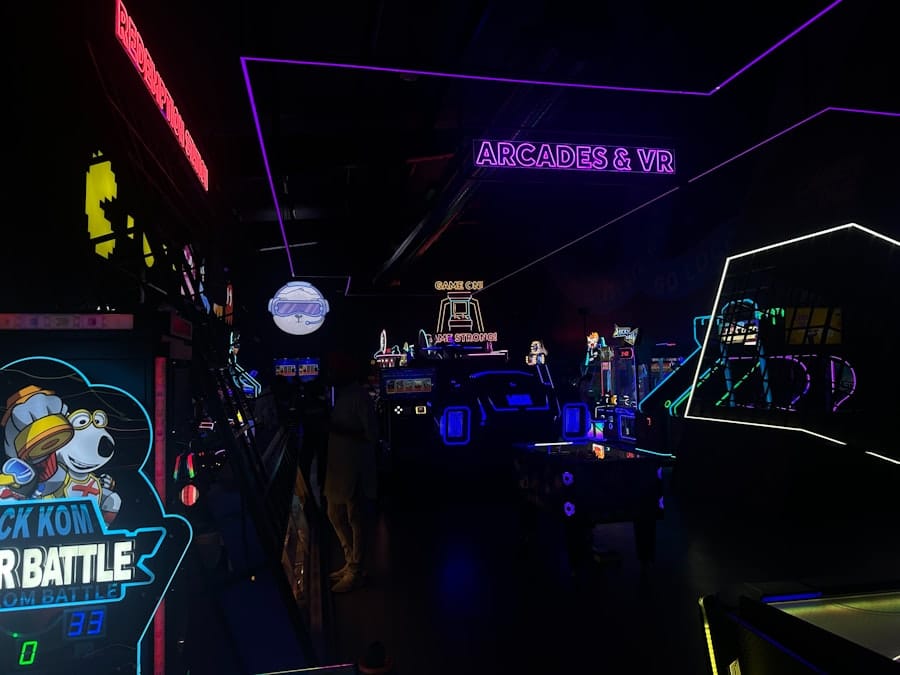Virtual Reality (VR) has emerged as a transformative technology that reshapes how players engage with digital content, particularly in the realm of role-playing games (RPGs). By immersing players in a three-dimensional environment where they can interact with the game world in a visceral manner, VR offers an unprecedented level of engagement. Traditional RPGs have long been celebrated for their ability to transport players into fantastical realms, allowing them to assume the roles of characters with unique abilities and narratives.
However, the advent of VR takes this experience to a new level, enabling players to not only see but also feel and interact with their surroundings in ways that were previously unimaginable. The integration of VR into RPGs has opened up new avenues for storytelling, character development, and player interaction. As players don headsets and step into these virtual worlds, they are no longer passive observers but active participants in the unfolding narrative.
This shift from traditional gaming paradigms to immersive experiences has sparked a renaissance in the RPG genre, attracting both seasoned gamers and newcomers alike. The potential for VR to create deeply personal and emotionally resonant experiences is vast, as it allows players to forge connections with their characters and the worlds they inhabit in ways that transcend conventional gameplay.
Key Takeaways
- VR and role-playing games offer a new level of immersion and interaction for players, combining the virtual world with storytelling and gameplay.
- Immersive storytelling in VR role-playing games allows players to feel like they are part of the game’s world, with a sense of presence and agency in the narrative.
- Enhanced player interaction in VR role-playing games enables more realistic and meaningful social interactions with non-player characters and other players.
- Realistic environments and graphics in VR role-playing games create a visually stunning and believable world for players to explore and interact with.
- Customization and personalization in VR role-playing games allow players to create unique avatars and experiences, adding a personal touch to the gameplay.
Immersive Storytelling in VR Role-Playing Games
One of the most compelling aspects of VR RPGs is their capacity for immersive storytelling. In traditional RPGs, narratives are often conveyed through text, dialogue trees, and cutscenes. While these methods can be effective, they lack the immediacy and emotional weight that VR can provide.
In a VR environment, players can experience stories from a first-person perspective, witnessing events unfold around them as if they were part of the narrative fabric. This immediacy fosters a deeper emotional connection to the characters and events, as players are not merely reading about a hero’s journey; they are living it. For instance, games like “Half-Life: Alyx” have demonstrated how VR can elevate storytelling by placing players directly in pivotal moments of the plot.
Players navigate through a richly detailed world filled with environmental storytelling elements that enhance the narrative without relying solely on dialogue. The ability to physically interact with objects and characters allows for a more nuanced understanding of the story, as players can uncover lore through exploration rather than exposition. This level of engagement transforms the act of storytelling into an interactive experience where players feel the weight of their choices and actions.
Enhanced Player Interaction in VR Role-Playing Games

The interaction mechanics in VR RPGs represent a significant evolution from traditional gaming interfaces. In conventional RPGs, players typically rely on controllers or keyboards to navigate menus and execute commands. However, VR introduces a more intuitive form of interaction that mimics real-world movements.
Players can use hand gestures to cast spells, draw weapons, or engage in conversations with NPCs (non-player characters), creating a sense of agency that enhances immersion. Take “The Elder Scrolls V: Skyrim VR” as an example; it allows players to physically swing their arms to wield weapons or cast spells, making combat feel more dynamic and engaging. This physicality not only makes gameplay more enjoyable but also encourages players to think strategically about their movements and actions within the game world.
The tactile feedback provided by VR controllers further enriches this experience, as players can feel the weight of their weapons or the resistance when interacting with objects, making every action feel consequential.
Realistic Environments and Graphics in VR Role-Playing Games
The visual fidelity of VR environments plays a crucial role in creating an immersive experience for players. Advances in graphics technology have enabled developers to craft stunningly realistic worlds that captivate players’ senses. In VR RPGs, these environments are not just backdrops; they are integral components of the gameplay experience.
Players can explore vast landscapes, intricate dungeons, and bustling cities that feel alive and responsive. Games like “Boneworks” exemplify this trend by offering highly interactive environments where players can manipulate objects and navigate through complex spaces. The attention to detail in these virtual worlds enhances immersion, as players can engage with their surroundings in meaningful ways.
The ability to look around and examine every nook and cranny adds layers of discovery that traditional RPGs often lack. Furthermore, realistic graphics contribute to the emotional weight of the narrative; when players witness breathtaking vistas or experience heart-wrenching moments in high fidelity, it deepens their connection to the story.
Customization and Personalization in VR Role-Playing Games
Customization has always been a hallmark of RPGs, allowing players to tailor their characters’ appearances, abilities, and playstyles. In the context of VR, this aspect takes on new dimensions as players can create avatars that reflect their identities or aspirations more accurately than ever before. The immersive nature of VR allows for detailed character creation processes where players can adjust facial features, body types, and even clothing in real-time.
This level of personalization fosters a sense of ownership over one’s character and enhances social interactions within the game. Players can embody characters that resonate with them on a personal level, leading to more meaningful connections with others in the virtual world.
Additionally, customization extends beyond aesthetics; players can also choose skills and abilities that align with their preferred playstyle, further enriching their gaming experience.
Social Integration and Multiplayer Experiences in VR Role-Playing Games

Enhanced Communication
In multiplayer settings, players can communicate through voice chat, body language, and gestures, conveying emotions and intentions more effectively. This level of interaction enables players to form genuine friendships and alliances, making the social experience feel more authentic.
Social Integration in VR Games
Games like “Rec Room” exemplify social integration by providing spaces where players can engage in various activities together, from cooperative quests to casual hangouts. The ability to see other players’ avatars move and react in real-time adds depth to social interactions, making it easier for individuals to connect on a personal level.
Building a Sense of Community
Shared experiences within these virtual worlds, such as completing quests or overcoming challenges, can strengthen bonds between players, fostering a sense of community that transcends geographical boundaries.
Physical Engagement and Movement in VR Role-Playing Games
Physical engagement is one of the most distinctive features of VR RPGs, as it encourages players to move their bodies in ways that traditional gaming does not. This aspect not only enhances immersion but also promotes physical activity, making gaming a more dynamic experience. Players can walk, run, jump, or crouch within the virtual space, allowing them to navigate environments in a way that feels natural and intuitive.
In games like “Sword Art Online: Alicization Lycoris,” players must physically engage with their surroundings to progress through challenges and combat scenarios. This physicality adds an extra layer of excitement to gameplay; for instance, dodging an enemy attack requires real movement rather than just pressing buttons. Such mechanics not only make combat more thrilling but also encourage players to be more aware of their physical space while gaming.
This blend of physical engagement with virtual experiences creates a unique synergy that enhances both enjoyment and immersion.
The Future of VR and Role-Playing Game Immersion
As technology continues to advance at an unprecedented pace, the future of VR in role-playing games holds immense potential for further immersion and innovation. With developments in haptic feedback technology, eye-tracking systems, and artificial intelligence, future VR RPGs may offer even more realistic interactions and experiences. Imagine a game where your character’s responses are influenced by your emotional state or where you can physically feel the impact of your actions through advanced haptic suits.
Moreover, as developers explore new storytelling techniques and gameplay mechanics tailored specifically for VR, we may see narratives that adapt dynamically based on player choices or interactions with NPCs. This could lead to highly personalized experiences where no two playthroughs are alike. The integration of augmented reality (AR) elements could also blur the lines between the physical world and virtual realms, creating hybrid experiences that further enhance immersion.
In conclusion, the evolution of VR technology is set to redefine how we experience role-playing games. As developers continue to push boundaries and explore new possibilities within this medium, players can look forward to increasingly rich narratives, enhanced interactions, and immersive worlds that invite them to step beyond mere gameplay into realms where they can truly live out their fantasies.
If you’re interested in immersive technology like virtual reality, you may also want to check out this article on how to choose the best laptop for graphic design. Just like VR is changing the future of role-playing game immersion, having the right tools for graphic design can greatly enhance your creative process and overall experience. Whether you’re a gamer or a designer, having the right technology can make a world of difference in your work.
FAQs
What is VR?
VR stands for virtual reality, which is a computer-generated simulation of an environment that can be interacted with in a seemingly real or physical way by a person using special electronic equipment, such as a helmet with a screen inside or gloves fitted with sensors.
How is VR changing the future of role-playing game immersion?
VR is changing the future of role-playing game immersion by providing a more immersive and realistic experience for players. With VR technology, players can feel like they are actually inside the game world, interacting with characters and environments in a way that was not possible with traditional gaming methods.
What are the benefits of using VR in role-playing games?
The benefits of using VR in role-playing games include increased immersion, a more realistic gaming experience, and the ability to physically interact with the game world. VR also allows for a greater sense of presence and agency, as players feel like they are truly part of the game environment.
What are some challenges of using VR in role-playing games?
Some challenges of using VR in role-playing games include the cost of VR equipment, potential motion sickness for some players, and the need for developers to create content specifically for VR. Additionally, VR technology is still evolving, so there may be technical limitations that need to be addressed.
How is VR technology evolving to improve role-playing game immersion?
VR technology is evolving to improve role-playing game immersion by advancing hardware capabilities, developing more sophisticated tracking and motion control systems, and creating more realistic and interactive game environments. Additionally, developers are working on ways to reduce motion sickness and improve comfort for VR players.

